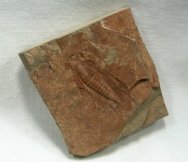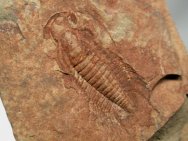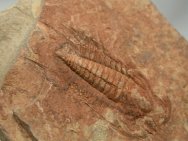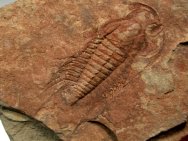Bathynotus
elongatus
Trilobites,
Order Redlichiida,
Suborder Redlichiina, Superfamily Redlichioidea, Family Chenkouaspidae
Geological
Time: Early Middle Cambrian
Size: Trilobite
is 14 mm long
Fossil
Site: Kaili Formation, Maiobanpo Section, Taijiang County, Kaili,
Guizhou Province, China
 The
Kaili Biota of Guiznou Province China, like the fantastic Chengjiang
and Burgess Shale
Fauna, preserve some of the earliest radiations of complex life
known on the planet. The formation is some 220 m in thickness and
spans the Late Early to Early Middle Cambrian. As such, its age
is intermediate between Changjiang and Burgess Shale Faunas. Representatives
of some 110 genera are known among eveven phyla. The Kaili Biota
includes both soft-bodied and skeletonized animals, and is dominated
by trilobites, with eocinoids (i.e., dawn crinoids) as the second
most common fossil. Kaili shares some 30 genera in common with Chengjiang and some 40 with the Burgess
Shale. The presence of Burgess Shale–like
fauna over a large part of southwestern China shows that the faunal
community was quite cosmopolitan in nature, indicating that preservation
was more of a factor in finding these concentrations of animals
than was the existence of isolated communities suitable for harboring
these myriad life forms. The
Kaili Biota of Guiznou Province China, like the fantastic Chengjiang
and Burgess Shale
Fauna, preserve some of the earliest radiations of complex life
known on the planet. The formation is some 220 m in thickness and
spans the Late Early to Early Middle Cambrian. As such, its age
is intermediate between Changjiang and Burgess Shale Faunas. Representatives
of some 110 genera are known among eveven phyla. The Kaili Biota
includes both soft-bodied and skeletonized animals, and is dominated
by trilobites, with eocinoids (i.e., dawn crinoids) as the second
most common fossil. Kaili shares some 30 genera in common with Chengjiang and some 40 with the Burgess
Shale. The presence of Burgess Shale–like
fauna over a large part of southwestern China shows that the faunal
community was quite cosmopolitan in nature, indicating that preservation
was more of a factor in finding these concentrations of animals
than was the existence of isolated communities suitable for harboring
these myriad life forms.
This
trilobite is Bathynotus elongatus. Bathynotus was the patronymic
genus of the Bathynotidae, a family whose ordinal status was in
dispute. The members of the genus have recently been assigned
to
the Chengkouaspidae, a family within Order Redlichiida.
Trilobites from this timeframe were members of one of only four
different orders: Redlichiida,
Ptychopariida, Corynexochida,
or Agnostida,
with the other trilobite orders appearing later in geologic time.
|
|




